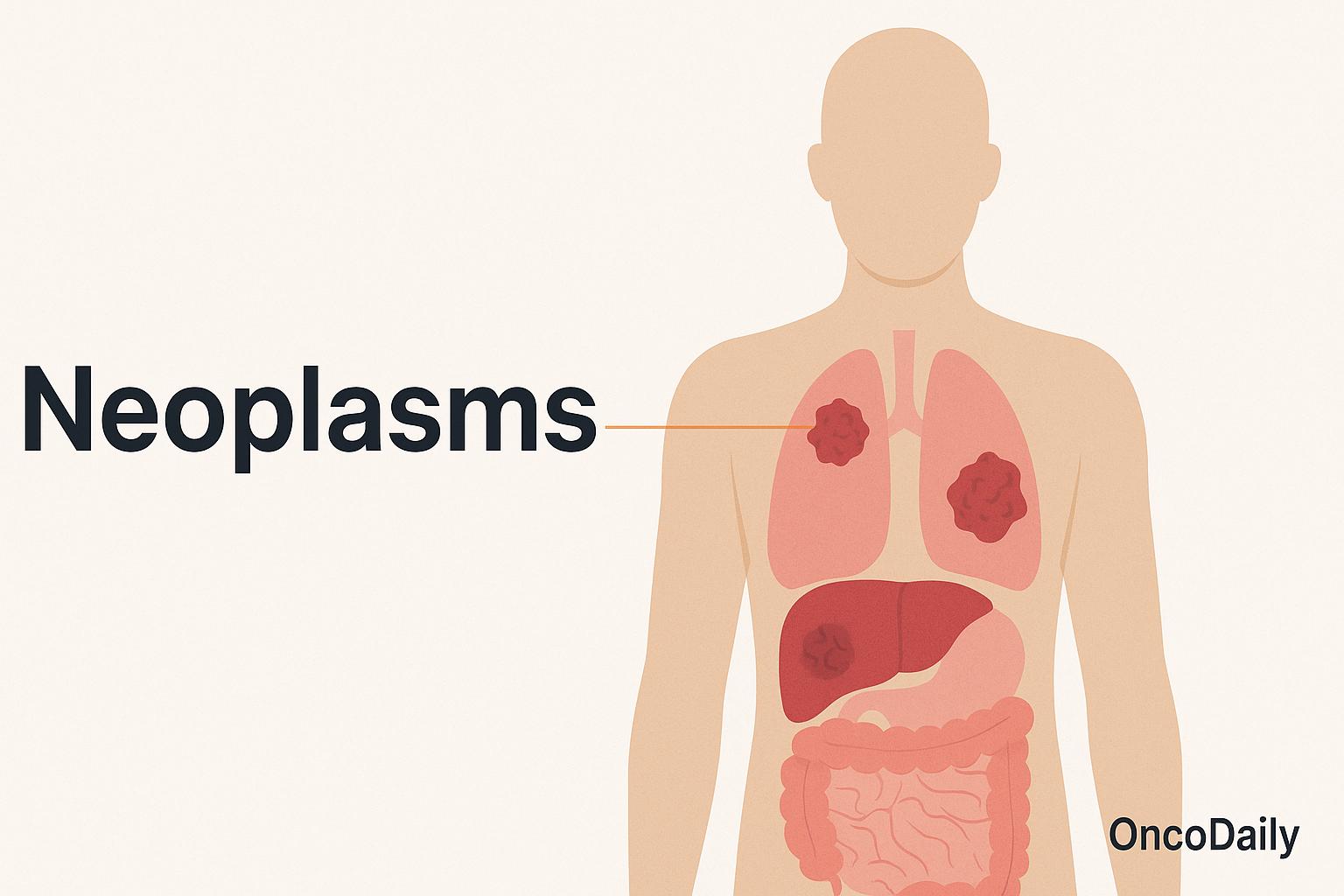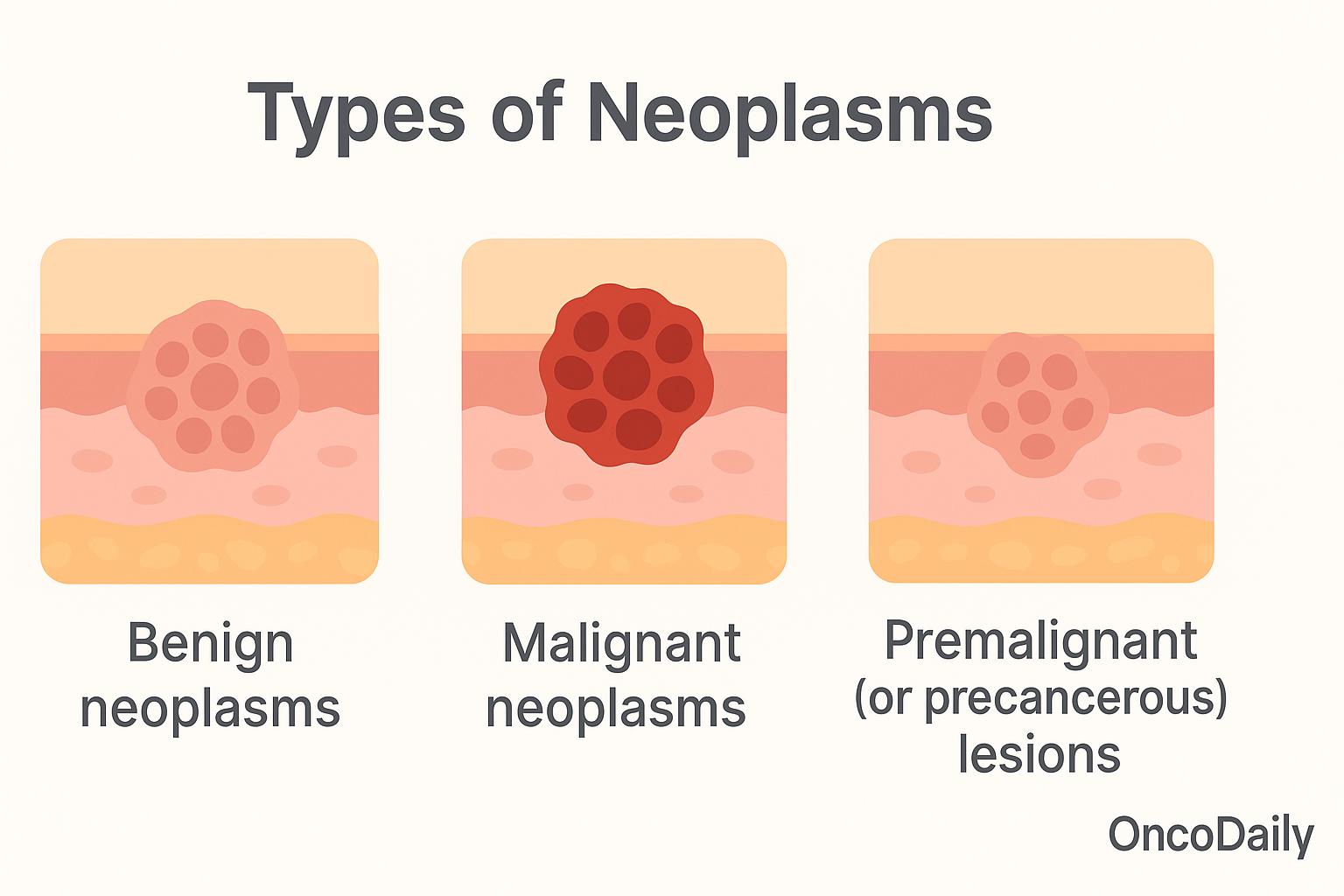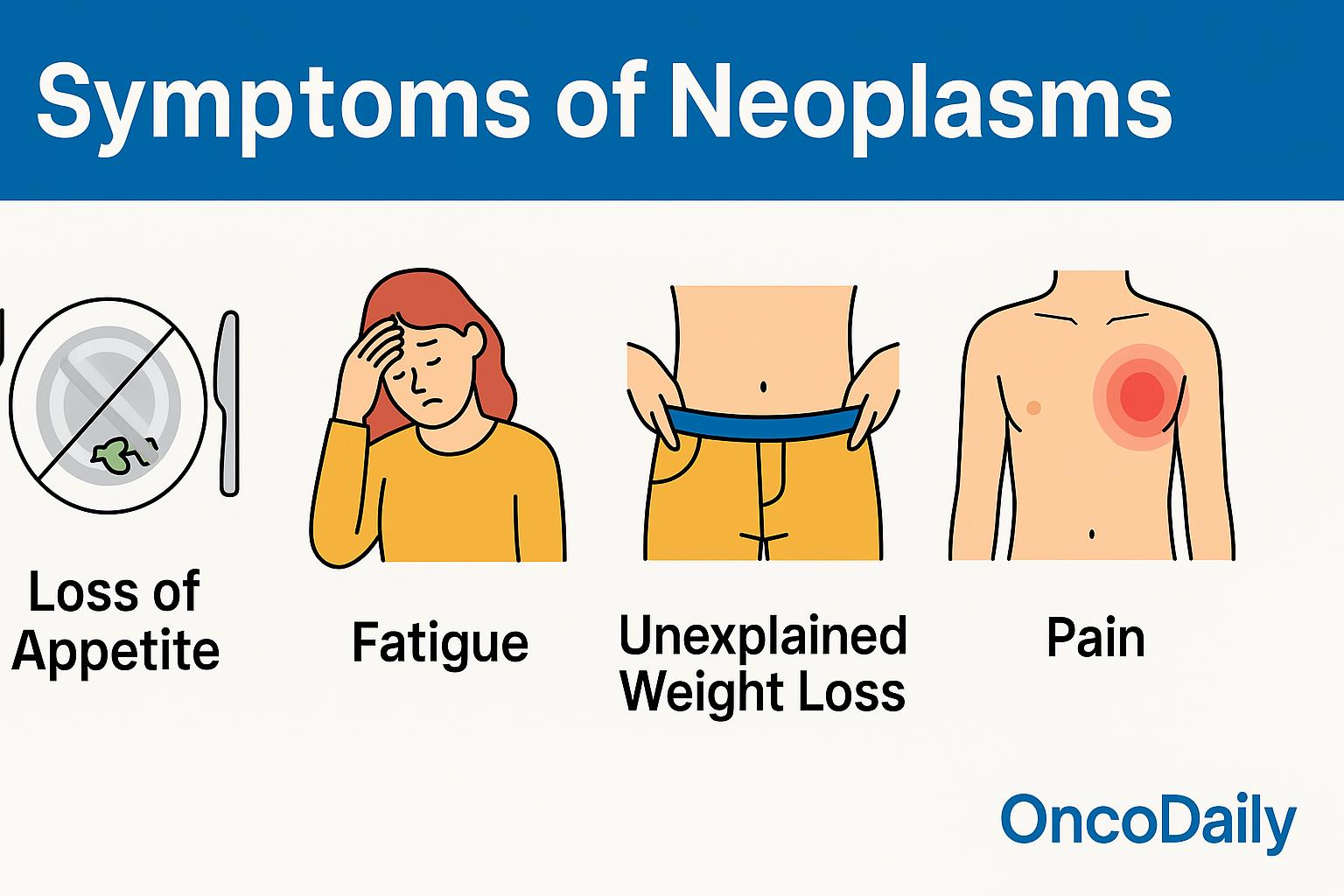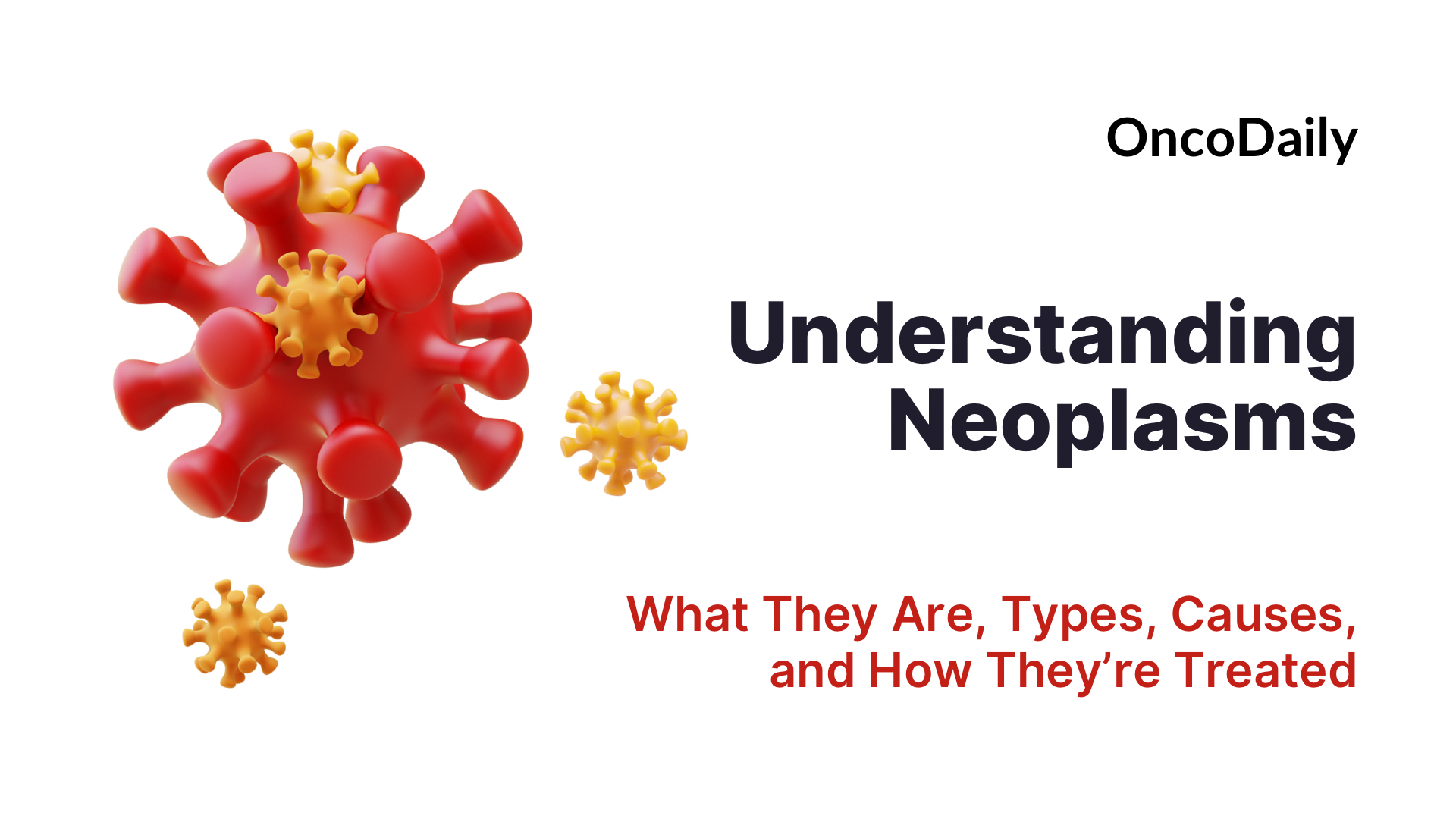A neoplasm, also known as a tumor, is an abnormal mass of tissue that arises when cells in the body begin to grow and divide uncontrollably. Unlike normal cells, which follow strict signals to divide, rest, or die, neoplastic cells escape these controls, leading to continuous growth. Neoplasms can vary widely in their behavior—some are harmless and slow-growing, while others are aggressive and can spread to distant parts of the body.
In this article, we’ll explore the different types of neoplasms (benign and malignant), their causes and risk factors, how they are diagnosed, the treatment options available, and what the prognosis may be depending on the type and stage.

Types of Neoplasms
Neoplasms are classified into three main categories based on their behavior and potential to cause harm:
- Benign neoplasms are non-cancerous growths that typically grow slowly and remain localized. They do not invade surrounding tissues or spread to other parts of the body. While they can cause symptoms if they press on nearby organs or structures, they are generally not life-threatening. Common examples include lipomas (fatty tumors under the skin) and uterine fibroids (muscle growths in the uterus).
- Malignant neoplasms, commonly referred to as cancers, are more aggressive. These tumors can invade nearby tissues, destroy normal structures, and spread to distant organs through the bloodstream or lymphatic system—a process called metastasis. Examples of malignant neoplasms include breast cancer, lung cancer, and leukemia.
- Premalignant (or precancerous) lesions are abnormal cell growths that are not yet cancer but have the potential to become malignant over time. Detecting and treating these early can prevent the development of cancer. Examples include colon polyps and cervical dysplasia, which can evolve into colorectal or cervical cancer if left untreated.

Causes and Risk Factors
The development of a neoplasm often begins with changes—mutations—in the DNA of cells that regulate growth, division, and death. These mutations may arise spontaneously or be triggered by a range of internal and external factors:
-
Genetic mutations in key regulatory genes can cause cells to multiply uncontrollably. These changes may affect tumor suppressor genes (which normally stop cell division) or oncogenes (which promote it).
-
Inherited conditions, such as BRCA1 and BRCA2 mutations, significantly increase the risk of developing certain cancers, including breast and ovarian cancer. These genetic predispositions are passed from parents to children and play a major role in some neoplasms.
-
Environmental exposures are a leading cause of DNA damage. Tobacco smoke, radiation, air pollutants, and exposure to industrial chemicals can all initiate or promote tumor growth over time.
-
Infectious agents contribute to several cancer types. For example, human papillomavirus (HPV) is strongly linked to cervical and throat cancers, hepatitis B and C viruses are linked to liver cancer, and Helicobacter pyloriinfection is associated with stomach cancer.
-
Hormonal imbalances and chronic inflammation—such as in inflammatory bowel disease—can create an environment that promotes abnormal cell growth and increases cancer risk.
-
Lifestyle factors like a poor diet, alcohol consumption, obesity, and lack of physical activity also influence cancer development, often by interacting with other risk factors to accelerate cellular changes.
Symptoms of Neoplasms
The symptoms of a neoplasm can vary greatly depending on where the tumor is located, its size, and whether it is benign or malignant. In some cases, a person may feel a lump or swelling—for example, in the breast, under the skin, or in the abdomen. Other symptoms can be more general, such as unexplained weight loss, persistent fatigue, pain, or unusual bleeding (like blood in the stool or urine, or postmenopausal bleeding).
Sometimes, the neoplasm causes symptoms by pressing on nearby organs or nerves, which can lead to discomfort, changes in bowel or bladder habits, difficulty breathing, or neurological symptoms. However, not all neoplasms cause noticeable signs. In fact, many are found incidentally during imaging tests (such as a CT or MRI) done for unrelated reasons. This is especially common with benign tumors or small early-stage cancers.

How Are Neoplasms Diagnosed?
Diagnosing a neoplasm involves several steps to determine its presence, type, and behavior. The process typically begins with imaging studies such as X-rays, CT scans, MRI, ultrasound, or PET scans. These help locate the tumor, assess its size, and detect whether it has spread to nearby or distant organs.
The most definitive way to diagnose a neoplasm is through a biopsy, where a sample of tissue is taken and examined under a microscope. This allows pathologists to determine if the tumor is benign or malignant, and to study its cellular features in detail. Blood tests, including tumor markers, may also be used to support the diagnosis or monitor the disease. These are substances produced by cancer cells or by the body in response to cancer, though they are not always specific.
Once the biopsy is complete, a detailed pathology report is prepared. This report provides critical information about the type of tumor, its grade (how abnormal the cells look), margins (whether the tumor was completely removed), and for certain cancers, the receptor status (such as hormone receptors in breast cancer). This information guides treatment decisions and helps predict the likely course of the disease.
Treatment Options
Treatment for neoplasms varies greatly depending on whether the growth is benign or malignant, as well as where it’s located, how large it is, and whether it has spread.
Benign tumors are often harmless and may not require any treatment at all. However, if they start causing symptoms—for example, by pressing on nearby organs or nerves—doctors may recommend surgical removal. In most cases, once a benign tumor is removed, it does not return. Malignant tumors, on the other hand, usually require a combination of treatments aimed at removing or destroying cancer cells and preventing the disease from spreading or coming back. Surgery is often the first step when the cancer is localized and operable. In some cases, it’s followed by radiation therapy to kill any remaining cancer cells in the area.
Chemotherapy may be used to attack cancer cells that have spread beyond the original tumor, as it travels through the bloodstream to reach distant sites. For cancers with specific genetic or molecular features, targeted therapies can block the signals that help cancer cells grow. Immunotherapy helps boost the body’s natural defenses to recognize and attack cancer more effectively. In some cancers—such as breast or prostate cancer—hormonal therapy is used to block hormones that fuel tumor growth.
Doctors often combine these treatments in a personalized plan, depending on the type and stage of the tumor, as well as the patient’s overall health and preferences. The goal may be to cure the cancer, slow its growth, or manage symptoms to improve quality of life.
Prognosis and Follow-Up
The outlook for neoplasms depends largely on whether they are benign or malignant. In general, benign neoplasms have excellent outcomes. They grow slowly, don’t spread to other parts of the body, and can often be completely removed with surgery. Once removed, they rarely return, and they usually don’t pose a serious threat to health.
Malignant neoplasms, or cancers, have a more variable prognosis. The outcome depends on the type of cancer, how early it’s diagnosed, whether it has spread (metastasized), and the overall health of the patient. Early-stage cancers that are caught before they spread typically have much better survival rates than advanced-stage cancers. That’s why early detection and routine follow-up are so important.
In recent years, advances in molecular testing and personalized medicine have significantly improved the way cancers are diagnosed and treated. By understanding the genetic makeup of a tumor, doctors can choose therapies that are more likely to work for a specific patient—leading to better outcomes and fewer side effects. As research continues to evolve, these innovations offer growing hope for people living with cancer.
When to See a Doctor
It’s important to see a doctor if you notice unusual or persistent symptoms, such as a lump that doesn’t go away, unexplained bleeding, sudden weight loss, or ongoing fatigue. These signs don’t always mean cancer, but they should never be ignored. Early evaluation can lead to quicker diagnosis and better outcomes, especially if a neoplasm is detected.
Routine screening tests, like mammograms, colonoscopy, or Pap smears, are also essential for finding certain types of cancer early—often before symptoms appear. These tests can detect abnormal growths while they’re still small and easier to treat. Staying up to date with recommended screenings based on your age, family history, and personal risk factors is one of the best ways to protect your health.
You Can Watch More on OncoDaily Youtube TV
Written by Toma Oganezova, MD
FAQ
What is a neoplasm?
A neoplasm is an abnormal growth of cells, also called a tumor. It can be benign (non-cancerous) or malignant (cancerous).
How is a neoplasm different from cancer?
Not all neoplasms are cancer. Only malignant neoplasms are considered cancer because they can invade tissues and spread.
What causes neoplasms?
Causes include genetic mutations, environmental exposures (like smoking or radiation), infections, and inherited conditions.
How are neoplasms diagnosed?
Diagnosis often involves imaging (like CT or MRI) and a biopsy, where a tissue sample is examined under a microscope.
What are common symptoms of tumors?
Symptoms may include lumps, pain, fatigue, unexplained weight loss, or bleeding—though some tumors cause no symptoms.
Can benign tumors turn into cancer?
Some premalignant tumors can develop into cancer over time, which is why early detection and treatment are important.
What treatments are available for neoplasms?
Options include surgery, chemotherapy, radiation, immunotherapy, and targeted therapy, depending on the tumor type and stage.
What’s the prognosis for malignant tumors?
Prognosis depends on cancer type, stage, and how early it is detected. Early treatment often improves outcomes.
When should I see a doctor?
See a doctor if you notice unusual symptoms like persistent lumps, bleeding, weight loss, or fatigue that won’t go away.
Are cancer screening tests important?
Yes—tests like mammograms, colonoscopies, and Pap smears help detect cancer early, when it’s most treatable.
